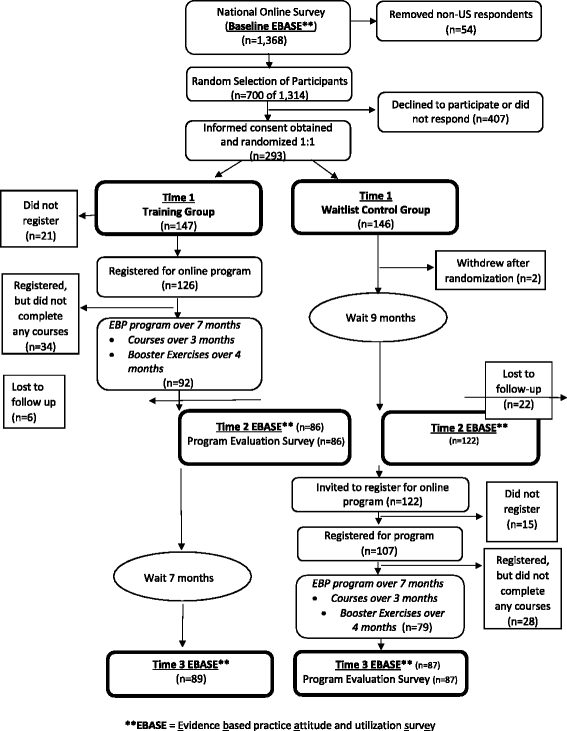The effectiveness and feasibility of an online educational program for improving evidence-based practice literacy: an exploratory randomized study of US chiropractors
- PMID: 27486510
- PMCID: PMC4970279
- DOI: 10.1186/s12998-016-0109-8
The effectiveness and feasibility of an online educational program for improving evidence-based practice literacy: an exploratory randomized study of US chiropractors
Abstract
Background: Online education programs are becoming a popular means to disseminate knowledge about evidence-based practice (EBP) among healthcare practitioners. This mode of delivery also offers a viable and potentially sustainable solution for teaching consistent EBP content to learners over time and across multiple geographical locations. We conducted a study with 3 main aims: 1) develop an online distance-learning program about the principles of evidence-based practice (EBP) for chiropractic providers; 2) test the effectiveness of the online program on the attitudes, skills, and use of EBP in a sample of chiropractors; and 3) determine the feasibility of expanding the program for broader-scale implementation. This study was conducted from January 2013 to September 2014.
Methods: This was an exploratory randomized trial in which 293 chiropractors were allocated to either an online EBP education intervention or a waitlist control. The online EBP program consisted of 3 courses and 4 booster lessons, and was developed using educational resources created in previous EBP educational programs at 4 chiropractic institutions. Participants were surveyed using a validated EBP instrument (EBASE) with 3 rescaled (0 to 100) subscores: Attitudes, Skills, and Use of EBP. Multiple regression was used to compare groups, adjusting for personal and practice characteristics. Satisfaction and compliance with the program was evaluated to assess feasibility.
Results: The Training Group showed modest improvement compared to the Waitlist Group in attitudes (Δ =6.2, p < .001) and skills (Δ =10.0, p < .001) subscores, but not the use subscore (Δ = -2.3, p = .470). The majority of participants agreed that the educational program was 'relevant to their profession' (84 %) and 'was worthwhile' (82 %). Overall, engagement in the online program was less than optimal, with 48 % of the Training Group, and 42 % of the Waitlist Group completing all 3 of the program courses.
Conclusions: Online EBP training leads to modest improvements in chiropractors' EBP attitudes and skill, but not their use of EBP. This online program can be delivered to a wide national audience, but requires modification to enable greater individualization and peer-to-peer interaction. Our results indicate that it is feasible to deliver an online EBP education on a broad scale, but that this mode of education alone is not sufficient for making large changes in chiropractors' use of EBP.
Keywords: Chiropractic; Evidence-based practice; Knowledge translation; Online education.
Figures
Similar articles
-
Skills, attitudes and uptake of evidence-based practice: a cross-sectional study of chiropractors in the Swedish Chiropractic Association.Chiropr Man Therap. 2021 Jan 11;29(1):2. doi: 10.1186/s12998-020-00359-w. Chiropr Man Therap. 2021. PMID: 33423697 Free PMC article.
-
US chiropractors' attitudes, skills and use of evidence-based practice: A cross-sectional national survey.Chiropr Man Therap. 2015 May 4;23:16. doi: 10.1186/s12998-015-0060-0. eCollection 2015. Chiropr Man Therap. 2015. PMID: 25949800 Free PMC article.
-
Investigating attitudes, skills, and use of evidence-based practice among Norwegian chiropractors; a national cross-sectional study.BMC Health Serv Res. 2023 Apr 20;23(1):385. doi: 10.1186/s12913-023-09354-2. BMC Health Serv Res. 2023. PMID: 37081471 Free PMC article.
-
Evidence-based practice, research utilization, and knowledge translation in chiropractic: a scoping review.BMC Complement Altern Med. 2016 Jul 13;16:216. doi: 10.1186/s12906-016-1175-0. BMC Complement Altern Med. 2016. PMID: 27412625 Free PMC article.
-
Facilitating interprofessional evidence-based practice in paediatric rehabilitation: development, implementation and evaluation of an online toolkit for health professionals.Disabil Rehabil. 2016;38(4):391-9. doi: 10.3109/09638288.2015.1041616. Epub 2015 Apr 29. Disabil Rehabil. 2016. PMID: 25924019 Review.
Cited by
-
The effectiveness of an on-line training program for improving knowledge of fire prevention and evacuation of healthcare workers: A randomized controlled trial.PLoS One. 2018 Jul 5;13(7):e0199747. doi: 10.1371/journal.pone.0199747. eCollection 2018. PLoS One. 2018. PMID: 29975723 Free PMC article. Clinical Trial.
-
Skills, attitudes and uptake of evidence-based practice: a cross-sectional study of chiropractors in the Swedish Chiropractic Association.Chiropr Man Therap. 2021 Jan 11;29(1):2. doi: 10.1186/s12998-020-00359-w. Chiropr Man Therap. 2021. PMID: 33423697 Free PMC article.
-
The Chiropractic Vertebral Subluxation Part 1: Introduction.J Chiropr Humanit. 2019 Apr 6;25:10-21. doi: 10.1016/j.echu.2018.10.002. eCollection 2018 Dec. J Chiropr Humanit. 2019. PMID: 31019417 Free PMC article.
-
Addressing barriers to the conduct and application of research in complementary and alternative medicine: a scoping review.BMC Complement Med Ther. 2021 Jul 15;21(1):201. doi: 10.1186/s12906-021-03371-6. BMC Complement Med Ther. 2021. PMID: 34266441 Free PMC article.
-
Restructuring of an evidence-based practice curriculum and assessment with structural mapping by course outcome verb.J Chiropr Educ. 2022 Mar 1;36(1):50-57. doi: 10.7899/JCE-20-22. J Chiropr Educ. 2022. PMID: 34424957 Free PMC article.
References
-
- Sackett DL, Straus SE, Richardson WS, Rosenberg W, Haynes RB. Evidence-based medicine. New York: Churchill Livingstone; 2000.
-
- Hall G. Attitudes of chiropractors to evidence-based practice and how this compares to other healthcare professionals: A qualitative study. Clin Chiropr. 2011;14:106–111. doi: 10.1016/j.clch.2011.06.003. - DOI
Grants and funding
LinkOut - more resources
Full Text Sources
Other Literature Sources


